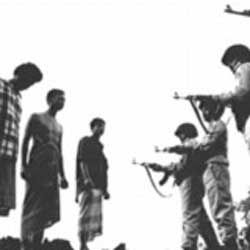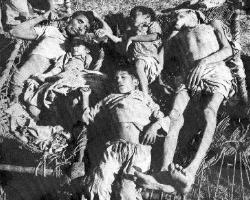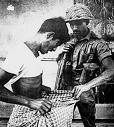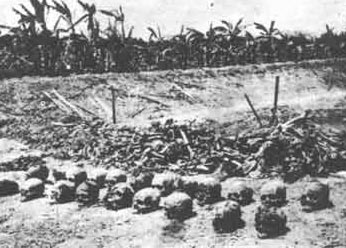“…… we were told to kill the hindus and Kafirs (non-believer in God). One day in June, we cordoned a village and were ordered to kill the Kafirs in that area. We found all the village women reciting from the Holy Quran, and the men holding special congregational prayers seeking God’s mercy. But they were unlucky. Our commanding officer ordered us not to waste any time.”
Confession of a Pakistani Soldier
It all started with Operation Searchlight, a planned military pacification carried out by the Pakistan Army started on 25 March, 1971 to curb the Bengali nationalist movement by taking control of the major cities on March 26, and then eliminating all opposition, political or military, within one month. Before the beginning of the operation, all foreign journalists were systematically deported from Bangladesh. The main phase of Operation Searchlight ended with the fall of the last major town in Bengali hands in mid May.
According to New York Times (3/28/71) 10,000 people were killed; New York Times (3/29/71) 5,000-7,000 people were killed in Dhaka; The Sydney Morning Herald (3/29/71) 10,000 – 100,000 were killed; New York Times (4/1/71) 35,000 were killed in Dhaka during operation searchlight.
The operation also began the 1971 Bangladesh atrocities. These systematic killings served only to enrage the Bengalis, which ultimately resulted in the secession of East Pakistan later in December, 1971. The international media and reference books in English have published casualty figures which vary greatly; 200,000–3,000,000 for Bangladesh as a whole.There is only one word for this: Genocide.
Genocide in Bangladesh, 1971
 The mass killings in Bangladesh (then East Pakistan) in 1971 vie with the annihilation of the Soviet POWs, the holocaust against the Jews, and the genocide in Rwanda as the most concentrated act of genocide in the twentieth century. In an attempt to crush forces seeking independence for East Pakistan, the West Pakistani military regime unleashed a systematic campaign of mass murder which aimed at killing millions of Bengalis, and likely succeeded in doing so.
The mass killings in Bangladesh (then East Pakistan) in 1971 vie with the annihilation of the Soviet POWs, the holocaust against the Jews, and the genocide in Rwanda as the most concentrated act of genocide in the twentieth century. In an attempt to crush forces seeking independence for East Pakistan, the West Pakistani military regime unleashed a systematic campaign of mass murder which aimed at killing millions of Bengalis, and likely succeeded in doing so.In national elections held in December 1970, the Awami League won an overwhelming victory across Bengali territory. On February 22, 1971 the generals in West Pakistan took a decision to crush the Awami League and its supporters. It was recognized from the first that a campaign of genocide would be necessary to eradicate the threat: “Kill three million of them,” said President Yahya Khan at the February conference, “and the rest will eat out of our hands.” (Robert Payne, Massacre [1972], p. 50.) On March 25 the genocide was launched. The university in Dacca (Dhaka) was attacked and students exterminated in their hundreds. Death squads roamed the streets of Dacca, killing some 7,000 people in a single night. It was only the beginning. “Within a week, half the population of Dacca had fled, and at least 30,000 people had been killed. Chittagong, too, had lost half its population. All over East Pakistan people were taking flight, and it was estimated that in April some thirty million people [!] were wandering helplessly across East Pakistan to escape the grasp of the military.” (Payne, Massacre, p. 48.) Ten million refugees fled to India, overwhelming that country’s resources and spurring the eventual Indian military intervention. (The population of Bangladesh/East Pakistan at the outbreak of the genocide was about 75 million.)
The Guinness Book of Records lists the Bangladesh Genocide as one of the top 5 genocides in the 20th century.
The gendercide against Bengali men
The war against the Bengali population proceeded in classic gendercidal fashion. According to Anthony Mascarenhas:There is no doubt whatsoever about the targets of the genocide. They were: (1) The Bengali militarymen of the East Bengal Regiment, the East Pakistan Rifles, police and para-military Ansars and Mujahids. (2) The Hindus — “We are only killing the men; the women and children go free. We are soldiers not cowards to kill them …” I was to hear in Comilla [site of a major military base] [Comments R.J. Rummel: "One would think that murdering an unarmed man was a heroic act" (Death By Government, p. 323)] (3) The Awami Leaguers — all office bearers and volunteers down to the lowest link in the chain of command. (4) The students — college and university boys and some of the more militant girls. (5) Bengali intellectuals such as professors and teachers whenever damned by the army as “militant.” (Anthony Mascarenhas, The Rape of Bangla Desh [Delhi: Vikas Publications, 1972(?)], pp. 116-17.)
Mascarenhas’s summary makes clear the linkages between gender and social class (the “intellectuals,” “professors,” “teachers,” “office bearers,” and — obviously — “militarymen” can all be expected to be overwhelmingly if not exclusively male, although in many cases their families died or fell victim to other atrocities alongside them). In this respect, the Bangladesh events can be classed as a combined gendercide and elitocide, with both strategies overwhelmingly targeting males for the most annihilatory excesses.London, 6/13/71). The Sunday Times…..”The Government’s policy for East Bengal was spelled out to me in the Eastern Command headquarters at Dacca. It has three elements:
1. The Bengalis have proved themselves unreliable and must be ruled by West Pakistanis;
2. The Bengalis will have to be re-educated along proper Islamic lines. The – Islamization of the masses – this is the official jargon – is intended to eliminate secessionist tendencies and provide a strong religious bond with West Pakistan;
3. When the Hindus have been eliminated by death and fight, their property will be used as a golden carrot to win over the under privileged Muslim middle-class. This will provide the base for erecting administrative and political structures in the future.”
Bengali man and boys massacred by the West Pakistani regime.
 Younger men and adolescent boys, of whatever social class, were equally targets. According to Rounaq Jahan, “All through the liberation war, able-bodied young men were suspected of being actual or potential freedom fighters. Thousands were arrested, tortured, and killed. Eventually cities and towns became bereft of young males who either took refuge in India or joined the liberation war.” Especially “during the first phase” of the genocide, he writes, “young able-bodied males were the victims of indiscriminate killings.” (“Genocide in Bangladesh,” in Totten et al., Century of Genocide, p. 298.) R.J. Rummel likewise writes that “the Pakistan army [sought] out those especially likely to join the resistance — young boys. Sweeps were conducted of young men who were never seen again. Bodies of youths would be found in fields, floating down rivers, or near army camps. As can be imagined, this terrorized all young men and their families within reach of the army. Most between the ages of fifteen and twenty-five began to flee from one village to another and toward India. Many of those reluctant to leave their homes were forced to flee by mothers and sisters concerned for their safety.” (Death By Government, p. 329.) Rummel describes (p. 323) a chilling gendercidal ritual, reminiscent of Nazi procedure towards Jewish males: “In what became province-wide acts of genocide, Hindus were sought out and killed on the spot. As a matter of course, soldiers would check males for the obligated circumcision among Moslems. If circumcised, they might live; if not, sure death.”
Younger men and adolescent boys, of whatever social class, were equally targets. According to Rounaq Jahan, “All through the liberation war, able-bodied young men were suspected of being actual or potential freedom fighters. Thousands were arrested, tortured, and killed. Eventually cities and towns became bereft of young males who either took refuge in India or joined the liberation war.” Especially “during the first phase” of the genocide, he writes, “young able-bodied males were the victims of indiscriminate killings.” (“Genocide in Bangladesh,” in Totten et al., Century of Genocide, p. 298.) R.J. Rummel likewise writes that “the Pakistan army [sought] out those especially likely to join the resistance — young boys. Sweeps were conducted of young men who were never seen again. Bodies of youths would be found in fields, floating down rivers, or near army camps. As can be imagined, this terrorized all young men and their families within reach of the army. Most between the ages of fifteen and twenty-five began to flee from one village to another and toward India. Many of those reluctant to leave their homes were forced to flee by mothers and sisters concerned for their safety.” (Death By Government, p. 329.) Rummel describes (p. 323) a chilling gendercidal ritual, reminiscent of Nazi procedure towards Jewish males: “In what became province-wide acts of genocide, Hindus were sought out and killed on the spot. As a matter of course, soldiers would check males for the obligated circumcision among Moslems. If circumcised, they might live; if not, sure death.”Robert Payne describes scenes of systematic mass slaughter around Dacca (Dhaka) that, while not explicitly “gendered” in his account, bear every hallmark of classic gender-selective roundups and gendercidal slaughters of non-combatant men:
Strikingly similar and equally hellish scenes are described in the case-studies of genocide in Armenia and the Nanjing Massacre of 1937.In the dead region surrounding Dacca, the military authorities conducted experiments in mass extermination in places unlikely to be seen by journalists. At Hariharpara, a once thriving village on the banks of the Buriganga River near Dacca, they found the three elements necessary for killing people in large numbers: a prison in which to hold the victims, a place for executing the prisoners, and a method for disposing of the bodies. The prison was a large riverside warehouse, or godown, belonging to the Pakistan National Oil Company, the place of execution was the river edge, or the shallows near the shore, and the bodies were disposed of by the simple means of permitting them to float downstream. The killing took place night after night. Usually the prisoners were roped together and made to wade out into the river. They were in batches of six or eight, and in the light of a powerful electric arc lamp, they were easy targets, black against the silvery water. The executioners stood on the pier, shooting down at the compact bunches of prisoners wading in the water. There were screams in the hot night air, and then silence. The prisoners fell on their sides and their bodies lapped against the shore. Then a new bunch of prisoners was brought out, and the process was repeated. In the morning the village boatmen hauled the bodies into midstream and the ropes binding the bodies were cut so that each body drifted separately downstream. (Payne, Massacre [Macmillan, 1973], p. 55.)
How many died?
Bangladeshi authorities claim that 3 million people were killed, while the Hamoodur Rahman Commission, an official Pakistan Government investigation, put the figure as low as 26,000 civilian casualties. The fact is that the number of dead in Bangladesh in 1971 was almost certainly well into seven figures. It was one of the worst genocides of the World War II era, outstripping Rwanda (800,000 killed) and probably surpassing even Indonesia (1 million to 1.5 million killed in 1965-66).
As R.J. Rummel writes:The human death toll over only 267 days was incredible. Just to give for five out of the eighteen districts some incomplete statistics published in Bangladesh newspapers or by an Inquiry Committee, the Pakistani army killed 100,000 Bengalis in Dacca, 150,000 in Khulna, 75,000 in Jessore, 95,000 in Comilla, and 100,000 in Chittagong. For eighteen districts the total is 1,247,000 killed. This was an incomplete toll, and to this day no one really knows the final toll. Some estimates of the democide [Rummel's "death by government"] are much lower — one is of 300,000 dead — but most range from 1 million to 3 million. … The Pakistani army and allied paramilitary groups killed about one out of every sixty-one people in Pakistan overall; one out of every twenty-five Bengalis, Hindus, and others in East Pakistan. If the rate of killing for all of Pakistan is annualized over the years the Yahya martial law regime was in power (March 1969 to December 1971), then this one regime was more lethal than that of the Soviet Union, China under the communists, or Japan under the military (even through World War II). (Rummel, Death By Government, p. 331.)People regard that the best option is to regard “3 million” as not an absolute but an arbitrary number. The proportion of men versus women murdered is impossible to ascertain, but a speculation might be attempted. If we take the highest estimates for both women raped and Bengalis killed (400,000 and 3 million, respectively); if we accept that half as many women were killed as were raped; and if we double that number for murdered children of both sexes (total: 600,000), we are still left with a death-toll that is 80 percent adult male (2.4 million out of 3 million). Any such disproportion, which is almost certainly on the low side, would qualify Bangladesh as one of the worst gendercides against men in the last half-millennium.
Who was responsible?
“For month after month in all the regions of East Pakistan the massacres went on,” writes Robert Payne. “They were not the small casual killings of young officers who wanted to demonstrate their efficiency, but organized massacres conducted by sophisticated staff officers, who knew exactly what they were doing. Muslim soldiers, sent out to kill Muslim peasants, went about their work mechanically and efficiently, until killing defenseless people became a habit like smoking cigarettes or drinking wine. … Not since Hitler invaded Russia had there been so vast a massacre.” (Payne, Massacre, p. 29.)There is no doubt that the mass killing in Bangladesh was among the most carefully and centrally planned of modern genocides. A cabal of five Pakistani generals orchestrated the events: President Yahya Khan, General Tikka Khan, chief of staff General Pirzada, security chief General Umar Khan, and intelligence chief General Akbar Khan. The U.S. government, long supportive of military rule in Pakistan, supplied some $3.8 million in military equipment to the dictatorship after the onset of the genocide, “and after a government spokesman told Congress that all shipments to Yahya Khan’s regime had ceased.” (Payne, Massacre, p. 102.)
 The genocide and gendercidal atrocities were also perpetrated by lower-ranking officers and ordinary soldiers. These “willing executioners” were fuelled by an abiding anti-Bengali racism, especially against the Hindu minority. “Bengalis were often compared with monkeys and chickens. Said Pakistan General Niazi, ‘It was a low lying land of low lying people.’ The Hindus among the Bengalis were as Jews to the Nazis: scum and vermin that [should] best be exterminated. As to the Moslem Bengalis, they were to live only on the sufferance of the soldiers: any infraction, any suspicion cast on them, any need for reprisal, could mean their death. And the soldiers were free to kill at will. The journalist Dan Coggin quoted one Punjabi captain as telling him, ‘We can kill anyone for anything. We are accountable to no one.’ This is the arrogance of Power.” (Rummel, Death By Government, p. 335.)
The genocide and gendercidal atrocities were also perpetrated by lower-ranking officers and ordinary soldiers. These “willing executioners” were fuelled by an abiding anti-Bengali racism, especially against the Hindu minority. “Bengalis were often compared with monkeys and chickens. Said Pakistan General Niazi, ‘It was a low lying land of low lying people.’ The Hindus among the Bengalis were as Jews to the Nazis: scum and vermin that [should] best be exterminated. As to the Moslem Bengalis, they were to live only on the sufferance of the soldiers: any infraction, any suspicion cast on them, any need for reprisal, could mean their death. And the soldiers were free to kill at will. The journalist Dan Coggin quoted one Punjabi captain as telling him, ‘We can kill anyone for anything. We are accountable to no one.’ This is the arrogance of Power.” (Rummel, Death By Government, p. 335.)- Pakistani Army Desecrated Churches in 1971
Eyewitness accounts
The atrocities of the razakars in killing the Bengalis equaled those of their Pakistani masters. An excerpt from an article written in the Azad, dated January 15, 1972, underscores the inhuman atrocities of the Pakistani troops and their associates, the razakar and al-Badr forces:‘….The people of Narail can bear witness to the reign of terror, the inhuman atrocities, inflicted on them after (General) Yahya let loose his troops to do what they would. After March 25, many people fled Jessore in fear of their lives, and took refuge in Narail and its neighboring localities. Many of them were severely bashed by the soldiers of Yahya and lost their lives. Very few people ever returned. Bhayna is a flourishing village near Narail. Ali Akbar is a well-known figure there. On April 8, the Pakistani troops surrounded the village on the pretext that it was a sanctuary for freedom fighters. Just as fish are caught in a net so too were the people of this village all assembled, in an open field. Then everyone- men, women, and children–were all forced to line up. Young men between the ages of 25 and 30 were lined up separately. 45 people were shot to death on the spot. Three of Ali Akbar’s brothers were killed there. Ali Akbar was able to save himself by lying on the ground. But no one else of that group was as fortunate. Nadanor was the Killing field. Every day 20 to 30 people were taken there with their hands tied behind their backs, and killed. The dead bodies would be flung into the river. Apart from this, a slaughter house was also readied for Bengalis. Manik, Omar, and Ashraf were sent to Jessore Cantonment for training and then brought to this slaughter house. Every day they would slaughter 9 to 12 persons here. The rate per person was Taka ten. On one particular day, 45 persons were slaughtered here. From April 15 to December 10, the butchery continued. It is gathered that 2,723 people lost their lives here. People were brought here and bashed, then their ears were cut off, and their eyes gouged out. Finally they were slaughtered… : The Chairman of the Peace Committee was Moulana Solaiman. With Dr. Abul Hussain and Abdul Rashid Mukhtar, he assisted in the genocide. Omar would proudly say, “During the day I am Omar, at night I am Shimar( legendary executioner famous for extreme cruelty). Don’t you see my dagger? There are countless Kafirs (heretics) on it.”
Chuknagar: The largest genocide during the Bangladesh Liberation War in 1971

Chuknagar is a small business town located in the Dumuria Thana of Khulna district and very close to the India Bangladesh border. In 71 thousands of refugees gathered in Chuknagar to go to Kolkata. According to a conservative account around ten thousand people were in Chuknagar waiting to cross the border.
In the early morning of May 10, the fatal day around 10am two trucks carrying Paki troops arrived at Kautala (then known as Patkhola). The Pakis were not many in number, most possibly a platoon or so. As soon as the Paki trucks stopped, the Pakis alighted from the truck carrying light machine guns (LMGs) and semi automatic rifles and opened fire on the public. Within a few minutes a lively town turned into a city of death.
The accounts of the two hundred interviewees were same. They differed only in details. “There were piled up dead bodies. Dead Kids’ on dead mum’s laps. Wives hugging their beloved husbands to protect them from killer bullets. Dads’ hugging their daughters to shield them. Within a flash they all were just dead bodies. Blood streamed into the Bhadra river, it became a river of corps. A few hours later when the Paki bastards ran out of bullets, they killed the rest of the people with bayonet.”
Source: Muntassir Mamun, The Archive of Liberation War, Bangabandhu and Bangladesh Research Institute
Further Documents and facts
Bangladesh Genocide Study Group at Kean University
“..It is Mujib’s home district. Kill as many bastards as you can and make sure there is no Hindu left alive,” I was ordered. – Colonel Nadir Ali, retired Pakistan Army Officer , Punjabi poet and short story writer
Denials
According to Gregory H. Stanton, President, Genocide Watch there are eight stages of a genocide. All of them are evident in the genocide commited by the Pakistan forces. The last of the eight stages is denial:It is among the surest indicators of further genocidal massacres. The perpetrators of genocide dig up the mass graves, burn the bodies, try to cover up the evidence and intimidate the witnesses. They deny that they committed any crimes, and often blame what happened on the victims.
No comments:
Post a Comment